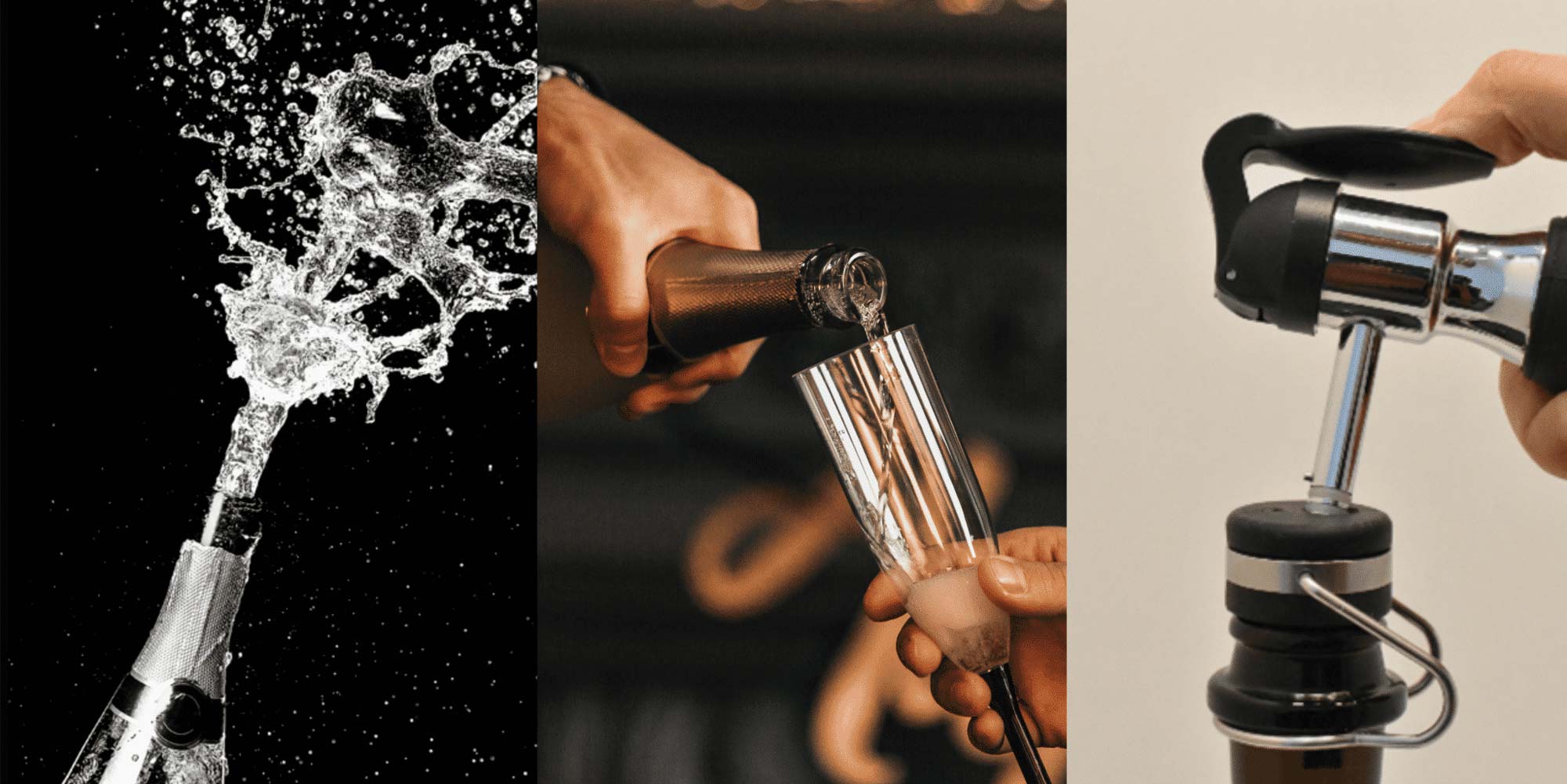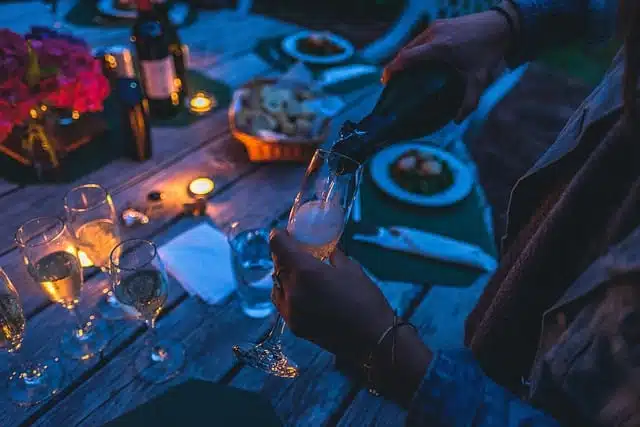Champagne bottle
Bubbl. the essential tool for champagne bottles
Bubbl. is a revolution for restaurateurs and all lovers of bubbles.
Thanks to this innovative system, it is now possible to extend the life of an opened bottle for more than a week without compromising the quality of this much sought-after drink and luxury product.

What is Bubbl. the Champagne conservation system?
Previously, an opened bottle quickly (within a few hours) lost its freshness (oxidation of the wine) and its effervescence (dissolved CO2 content), which limited the ability of restaurants to serve effervescent wine by the glass. With Bubbl, this deterioration linked to the loss of use is reduced to almost zero. The system prevents premature oxidation of the wine and preserves its bubbles, thanks to the injection of an oenological gas composed of CO2 and nitrogen.
The origin of Bubbl. technology for champagne
Bubbl. is based on the Wikeeps system technology, patented in 2012 and widely used by wine professionals to preserve and serve wine. Bubbl. is a reliable, tried-and-tested tool that’s widely appreciated by wine professionals and enthusiasts alike.
Thanks to Bubbl., restaurateurs can now expand their range of wine by the glass.
They can offer their customers the chance to discover a wider variety of Champagne and sparkling wines in general, while at the same time reducing the losses incurred on each bottle opened.
As it did 10 years ago with wine by the glass, Bubbl. will enable every professional to showcase the best cuvée from the winemaker, the white, the rosé, the non-dosed… without any limits and to express the full palette of a terroir and a champagne house.
FAQ – How to choose your champagne?
1. What is the name of a 9-litre bottle?
A 9-litre bottle of Champagne is called a Salmanazar. The name refers to Salmanazar, an ancient king of Assyria. It is common practice in the champagne and wine industry to give biblical names to large bottles.
A Salmanazar contains the equivalent of 12 standard bottles of wine or champagne (each standard bottle containing 750 ml). Large bottles like the Salmanazar are often used for celebrations or special events because of their impressive size.
In addition, some wine lovers argue that large bottle sizes can improve the ageing process of wine, as wine ages more slowly in a large bottle compared to a standard bottle.
It’s also worth noting that large bottles, including Salmanazars, are often filled from standard bottles to ensure the quality of the wine or champagne.
2. What are the different sizes of champagne bottle?
There are several sizes of champagne bottle, ranging from the smallest, known as the ‘Demi’ or ‘Half’, to the largest, the ‘Melchizedek’. Here is a list of the most commonly used sizes:
- Demi or Half: contains 375 millilitres, or half a standard bottle.
- Standard bottle: contains 750 millilitres. Magnum: contains 1.5 litres, the equivalent of two standard bottles.
- Jeroboam: contains 3 litres, the equivalent of four standard bottles.
- Rehoboam : contains 4,5 litres, the equivalent of six standard bottles.
- Methuselah: contains 6 litres, the equivalent of eight standard bottles.
- Salmanazar : contains 9 litres, the equivalent of twelve standard bottles.
- Balthazar : contains 12 litres, the equivalent of sixteen standard bottles.
- Nebuchadnezzar : contains 15 litres, the equivalent of twenty standard bottles.
- Melchizedek ou Midas : contains 30 litres, the equivalent of forty standard bottles.
These sizes are not all commonly used; beyond Nebuchadnezzar, they are generally reserved for special occasions. These names, most of which are biblical in origin, are specific to sparkling wines such as Champagne. Bottle sizes for non-sparkling wines may have different names and volumes.
3. How much does a bottle of Champagne cost?
The price of a bottle of Champagne can vary greatly depending on a number of factors, including the type of Champagne, whether it’s brut, white, pink or other variants. In addition, the brand, vintage, bottle size and place of purchase can all influence the cost of this luxurious form of sparkling wine.
- Entry-level Brut Champagne: Entry-level non-vintage brut Champagnes from good brands can cost around €30 to €50. The term ‘brut’ indicates a dry wine with little sugar added during dosage.
- Champagne Blanc de Blancs milieu de gamme : Pour le Champagne Blanc de Blancs, fabriqué uniquement à partir de raisins blancs, généralement du Chardonnay, les prix pour les marques de milieu de gamme peuvent varier de 50 à 100 euros.
- Top-of-the-range Brut champagnes: For brut champagnes from prestigious brands such as Dom Pérignon or Krug, you can expect to pay anywhere from 100 to several hundred euros per bottle.
- Luxury Champagnes: For collectible bottles of Champagne, which may include vintage Champagnes or larger bottle formats, prices can rise to several thousand euros.
These prices are general estimates and may vary according to market and demand. Champagne’ is a sparkling wine specific to the Champagne region of France and carries an appellation d’origine contrôlée (AOC). However, other regions of the world also produce excellent sparkling wines, which can offer remarkable value at lower prices than Champagne.
4. What is the best-selling champagne?
Moët & Chandon is the world’s best-selling champagne brand. The champagne house, based in Épernay in France, is renowned for its high-quality cuvées and innovative winemaking techniques. It is also famous for its Champagne Brut Impérial, which is one of the most popular bottles of champagne on the international market.
However, it is important to note that a brand’s popularity can vary depending on many factors, including the specific market, the region, and individual consumer preferences. For example, there are other great champagne houses that are also highly recognised worldwide, such as Veuve Clicquot, Nicolas Feuillatte, Ruinart, Bollinger, Heidsieck, Taittinger and Laurent-Perrier.
As for the so-called luxury or prestige bottle, Dom Pérignon (which is produced by Moët & Chandon) and Louis Roederer Cristal are among the most sought-after and appreciated brands.
It’s worth noting that although these brands are widely sold and appreciated, the quality of champagne can vary considerably: depending on the blend, whether brut, rosé, blanc de blanc, even within a single brand, the vintage, the cuvée, and other factors.

